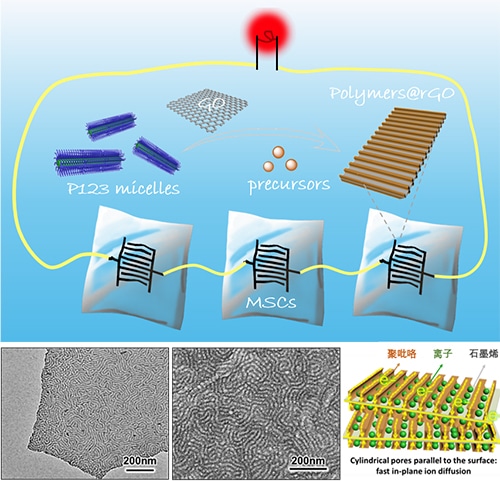Jun 11 2019
A team of researchers has recently created 2D polymers with in-plane cylindrical mesopores on graphene nanosheets for micro-supercapacitors (MSCs).
 Schematic of the fabrication of 2D mesoporous polymer/graphene with in-plane cylindrical pores for MSCs; Morphological characterizations of mesoporous polypyrrole/graphene nanosheets; Schematic diagram of the roles of cylindrical mesopores parallel to graphene surface in the high performance of planar MSCs. (Image credit: QIN Jieqiong and HOU Dan)
Schematic of the fabrication of 2D mesoporous polymer/graphene with in-plane cylindrical pores for MSCs; Morphological characterizations of mesoporous polypyrrole/graphene nanosheets; Schematic diagram of the roles of cylindrical mesopores parallel to graphene surface in the high performance of planar MSCs. (Image credit: QIN Jieqiong and HOU Dan)
The group was headed by Professor WU Zhongshuai from the Dalian Institute of Chemical Physics (DICP) of the Chinese Academy of Sciences, in association with MAI Yiyong from Shanghai Jiao Tong University. The results of the study have been reported in Angewandte Chemie International Edition.
Graphene is an example of two-dimensional (2D) nanomaterial that has extraordinary properties, which are absent in their bulk materials. Conversely, these 2D nanosheets have a tendency to aggregate or stack together, which results in restricted accessibility of active sites and, therefore, unfulfilled performance in energy-relevant applications, for example, MSCs.
Growing electrochemically active moieties on 2D nanosheets to create 2D heterostructures, which look like sandwiches, has been shown to be a potential method to prevent stacking and thus enhance their capacitive performance in MSCs. By contrast, mesoporous structure in electrode materials can mostly reserve the electrolyte, raise specific surface area, and enable the ionic diffusion pathways.
Thus, when well-defined mesoporous electrochemically active materials are patterned on free-standing nanosheets, like graphene, innovative 2D sandwich-structured hybrid nanomaterials are produced for high-performance MSCs. However, this still continues to be a major challenge because of the lack of innovative methods and appropriate templates.
In order to deal with the above problem, the researchers used the interface self-assembly strategy to synthesize polydopamine, polyaniline, and polypyrrole with in-plane cylindrical mesopores on graphene nanosheets.
The 2D sandwich-structured nanohybrids, thus produced, were used as the interdigital microelectrodes for assembling planar MSCs, which provided excellent energy density and volumetric capacitance. In addition, the MSCs exhibited extraordinary flexibility and superior integration for increasing output capacitance and voltage.
The new interfacial self-assembly strategy paves the way for new opportunities for patterning 2D porous graphene nanosheets specifically for planar energy storage devices.